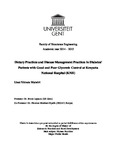| dc.contributor.author | Mutwiri, Linet Nkirote | |
| dc.date.accessioned | 2018-11-21T14:02:38Z | |
| dc.date.accessioned | 2020-02-07T06:08:28Z | |
| dc.date.available | 2018-11-21T14:02:38Z | |
| dc.date.available | 2020-02-07T06:08:28Z | |
| dc.date.issued | 2015 | |
| dc.identifier.citation | Mutwiri, L.N. (2015). Dietary practices and disease management practices in diabetes' patients with good and poor glycemic control at Kenyatta National Hospital (KNH). Unpublished Master’s Dissertation. University of Gent. Gent, Belgium. | en_US |
| dc.identifier.uri | http://repository.must.ac.ke/handle/123456789/1159 | |
| dc.description.abstract | Background: Compliance to appropriate dietary recommendation and observation of
appropriate disease management practices is a well-known integral part in the care and
management of Type-2-diabetes. Dietary and lifestyle practices of T2DM subjects in Kenya are
still unclear.
Objective: This study aimed at assessing T2DM risks profile, dietary practices and exploring
the experiences of patients attending the outpatient diabetes clinic at the Kenyatta National
Hospital (KNH), Nairobi, Kenya
Study Design: A case-control study design was conducted with cases referring to the study
subjects with T2DM whose blood glucose levels that are outside the above ranges suggested by
NICE and controls referring to study subjects whose blood glucose levels lie in the ranges
suggested by the NICE guidelines.
Methods: Associations were studied in 157 T2DM outpatients aged 18 years and above (up to
65years), undergoing treatment and care at the KNH outpatient diabetes clinic. Dietary intake
was assessed using a 24-hour recall questionnaire. Disease management practices such as
medication use, medical check-ups amongst others was obtained from an intervieweradministered
questionnaire.
Data Analysis: Data was analyzed using SPSS v.22.0 for Windows
Results: One-hundred and fifty seven participants (75 males, 82 females). 54.7% of the study
population had attained the NICE recommended target post-prandial blood glucose level range
(under 8.5mmol/L). Abdominal obesity, BMI and dietary practices were risk factors that were
analyzed for this population.
Conclusion: The risk factors for type 2 diabetes mellitus associated with poor glycemic control
described in this urban population included low self-reported compliance to recommendations
given by health-service providers. The poor glycemic group of study subjects also had a
statistically significant higher number of hospital admissions due to diabetic ketoacidosis.
Reasons for non-compliance and non-adherence to recommendations by patients should be
addressed by future studies to provide more insight in this area. | en_US |
| dc.language.iso | en | en_US |
| dc.publisher | Universitiet Ghent | en_US |
| dc.subject | Type-2-diabetes mellitus | en_US |
| dc.subject | diabetes risk factors | en_US |
| dc.subject | Disease Management Practices | en_US |
| dc.title | Dietary practices and disease management practices in diabetes' patients with good and poor glycemic control at Kenyatta National Hospital (KNH) | en_US |
| dc.type | Thesis | en_US |

